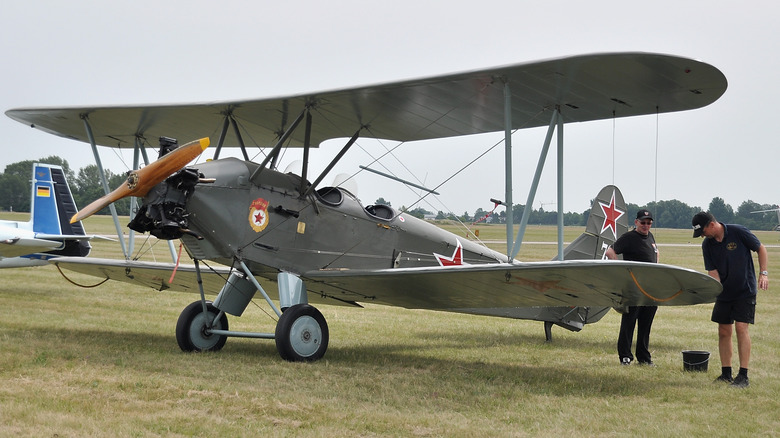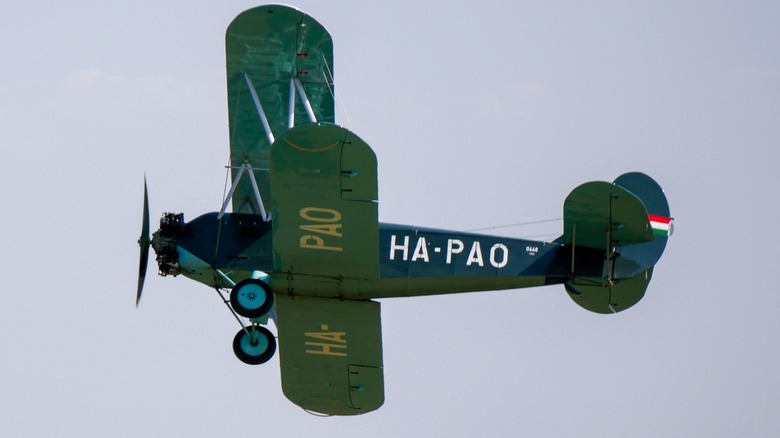The Unlikely Way A Propeller Plane Outmaneuvered A Fighter Jet During The Korean War
Even veteran fliers may not have journeyed on a propeller plane before. For some, they may be seen as something of a relic, left behind as the world embraced the great, screeching roar of the jet engine. However, some modern aircraft still use propellers, including the C-130 Hercules transport plane. Nevertheless, propeller aircraft had already started to fall out of fashion by the Korean War, in which piston-engine aircraft were prominently used by both sides.
According to the National Museum of the United States Air Force, Lt. Gen. E. George Stratemeyer of the Far East Air Forces boasted that "air supremacy over Korea was quickly established," as the air power the United States could bring to bear was far superior at the beginning of the conflict. The outlet reports that North Korea had just 140 World War II-era piston-engine aircraft with which to oppose them. Sometimes, though, it's the outnumbered and outgunned that score the most extraordinary victories. One North Korean propeller plane, a humble Polikarpov PO-2, "defeated" — in air quotes — one of the most advanced aircraft utilized during the Korean War, the U.S. Lockheed F-94 Starfire.
The Starfire, with a top speed of about seven times that of the PO-2's leisurely 94 mph, probably thought that it had easy prey lined up when it set out in pursuit. Its undoing, though, was the sheer mismatch between the two planes. It had to slow down to attempt to target the PO-2 and stalled when forced to move at such a slow speed. The pilot was unable to regain control, and the Starfire crashed, killing the 319th Fighter Squadron commander at the controls. The pilot of the PO-2, meanwhile, surely couldn't believe their luck.
The P-02 has a history of bamboozling opposing attack aircraft
The PO-2's escape from this situation seems like nothing more than an incredibly lucky fluke. If any aircraft was going to pull off such a miraculous and high-profile "victory," though, it would be the PO-2. This humble old aircraft just had a way of succeeding against the odds and using its own low-tech nature as a survival technique.
The PO-2 was a two-seater biplane which was already severely outdated and outclassed on paper when it was used in World War II. In that conflict, it was flown by the Soviet Union's 588th Night Bomber Regiment — also known as the formidable all-female Night Witches. Slow and with an astonishingly vulnerable plywood frame, it would have stood little chance as a fighter, but its brave pilots found a valuable niche using it in stealthy night flights. The crew member in the second seat wielded a small clutch of bombs, and they would attempt to unleash as much damage as they could on their German targets.
Because these planes needed to fly close to the ground and flew at such low speeds, they were very difficult to target for long enough to get a clear shot — as the doomed Starfighter would later find during the Korean War. As a result, stalling was an equal danger to the German fighter planes of the time. Couple this with the fact that the wooden body of the PO-2 helped to foil radar-centric strategies, and the women who flew these aircraft were able to brilliantly turn just about every shortcoming it had into a positive.
Propeller planes like the PO-2 continued to decline after the Korean War
The heroics of World War II's Night Witches will always be a proud part of the PO-2's legacy, but as the Korean War wore on, it became increasingly plain that jets would predominantly be the deciding aircraft in future aerial combat. When the U.S. Air Force unleashed its Shooting Star, the F-80C, in Korea, it became the force's first jet to see service and was equipped with a varied arsenal including a 2,000-lb bomb payload alongside its guns.
The Starfire was an iteration on the Shooting Star, incorporating parts of its structure while adjusting other aspects to better suit the needs of the new model such as a revised nose shape to incorporate weaponry and radar advancements. However, the U.S. Air Force also needed a model that was a match for the MiG-15, an opposing jet that had joined the fray by the end of 1950. The F-86 Sabre, which boasted a top speed of 685 mph and a formidable crop of .50 machine guns, seemed to relish that role, with its pilots downing 792 of the deadly opposing fighters. The competition between these aircraft would help herald a new age of jet fighters in combat.
One of the final U.S. fighter planes that used a propeller was the legendary A-1 Skyraider, pictured here, which flew from 1945 until 1973. It's remarkable that it lasted that long in service, but if the PO-2 has taught us anything, it's that you underestimate a seemingly inferior foe at your peril. Technological advantages, as huge as they'll typically be, aren't always everything.


